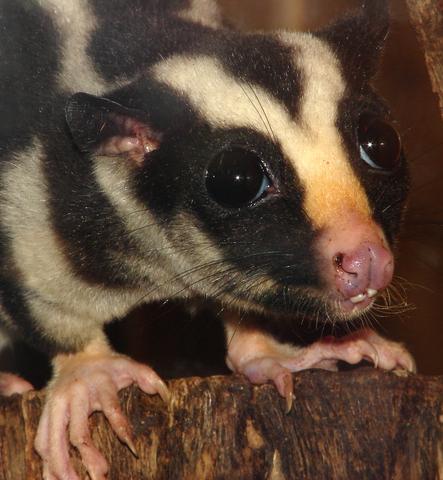
Striped possum(Dactylopsila trivirgata)
Phylum —chordata
Class — mammalia
Order — diprotodontia
Family — petauridae
Genus – dactylopsila
Appearance
This possum looks like a black and white squirrel. The body length is approx. 263 mm, tail – 325 mm, and weight – 423 g. The Striped possum's tail is prehensile. Its fourth finger is elongated relative to the others and is used to take beetles and caterpillars from tree bark, making it a "mammalian woodpecker".
Habitat
Striped possums inhabit Australia and New Guinea, including some nearby islands.
Behavior
It is solitary, mostly nocturnal, arboreal, and builds nests in tree branches.It emits a "very powerful unpleasant smell." It is noisy and growls. During the day it curls up on an exposed branch and sleeps.
Diet
The Striped possum eats leaves, fruits, and small vertebrates. Its main diet consists of wood-boring insect larvae, which are extracted from rotten branches probing with its elongated fourth finger and its powerful incisor teeth which are used to rip open tree bark to expose insects. It detects the larvae by a rapid drumming along branches with the toes of its forefoot. The fourth finger has an unusual hooked nail which it uses to extract insects out of cracks.
Reproduction
The female Striped possum has two teats in her pouch and can give birth to up to two young.Mating occurs from February to August. Young possums live with its mother for more than a year.
In captivity
They live up to 4-5 years in captivity.
The enclosures housing either a pair (or the female alone or with its young when the male was being housed separately) measured either 3.5m x 2.8m x 2.4m (high) or 4.2 m x 3.4m x 2.4m (high) whilst those housing separated males were 2.5m x 2.5m x 2.4m (high). Separated males are housed in a room completely separated from the females. The temperature should be between 22 and 26 degrees centigrade during the day, whilst in the evening temperatures are at around 18-20 degrees centigrade. The humidity should be between 65-75%. Full spectrum lighting is provided. Typically, the lighting regime is 12 hours on and 12 hours off.
Two wooden boxes and one rotten tree trunk are always provided – even with only one animal inside – at heights between 1.7 and 2.2 meters. Ropes and fresh tree branches of various dimensions are put throughout the enclosure. The substrate consists of peat-based garden compost mixed with dead leaves from beech and oak.
All animals are provided with a widely varied diet. The daily diet consists of a mixture of approximately 50% of fruits, 40% of insects, prepared insect-based mix and animal meat and 10% nectar mixture. Once a week the animals also should have a hard-boiled egg. All insects are sprinkled with a calcium and Vitamin D3 powder. Once a week food is lightly sprinkled with Spirulina powder (powdered green algae), food is also sprinkled once a week with a multi-vitamin and trace element supplement.
The daily fruit ration consists of a mixture of six different fruits and usually around ten of them. Primarily fruit items include banana, mango, papaya, ripe pear, soft apple, kiwi fruit and persimmon. Additional items are varied day by day and week by week. These additional items include sweet orange, blueberries, blackberries, raspberries, tomatoes, grapes, rowan berries, passion fruit and peaches.
The animal protein component is comprised of live and defrosted crickets, mealworms, giant mealworms and locusts together with a small amount of minced turkey or minced chicken. The final component of the diet is a self-made nectar mixture comprised of fruit yoghurt, Complan powder, honey and powered fruit or rice,flavored human baby foods mixed with warm water to a consistency a little thicker than full fat milk.
 Russian
Russian
 English
English
























